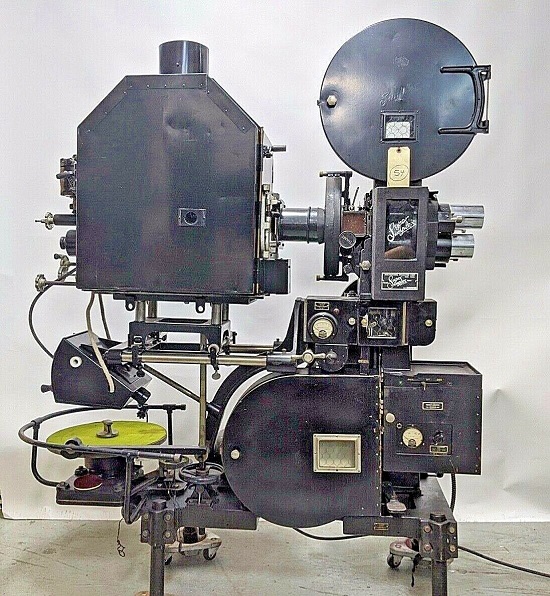Chapter 37
Attending the Cinefest
Attending the Cinefest
It was about the time that I resigned from the Defamatory Cinema that I first attended
the Syracuse Cinefest,
which, to my delight, had a pair of Western Electric bases with variable speed and full Silent apertures,
MovieTone apertures, and Academy apertures.
Those machines were under the charge of a superb projectionist named Bob Hodge.
The machines went back and forth between the
Palace and the
Loew’s State Landmark
to run silent films.
By the mid-1990’s they had to be retired,
because replacement parts could no longer be obtained.
The Loew’s State Landmark then paid for a conversion
of its own machines and continued showing silents correctly for the Cinefest,
until the organizer, Phil Serling — yes, Rod’s cousin — passed away.
The Cinefest continued without him through 2015,
but then it ground to a halt.
Terrible pity.
This is a Western Electric base and sound reproducer,
with a synchronized turntable for Vitaphone as well as for Western-Electric sound-on-disc films.
The drive motor is variable speed, to accommodate silent films and, more importantly,
the anticipated 100'/min speed proposed by E.I. Sponable, which never came to be.
The lamphouse is by Hall & Connolly.
The Super Simplex picture head does not match any Super Simplex I have ever seen.
I am certain it has a choice of two and only two apertures, which are on a slider:
either Silent or MovieTone as one choice, and “Proportional” as the other choice.
That is why there is a turret for a pair of lenses, one to match each aperture.
When I was a projectionist in the 1980’s, this equipment was considered “throwable” —
junk fit only to be thrown into the dumpster.
If you wanted to buy this stuff, you could do so for a couple of hundred dollars, or maybe less,
or maybe you could just haul it away for the asking.
It was considered worthless.
People who had these machines had trouble giving them away for free.
Then 17 December 2010 happened.
All manufacture and all support was suddenly cut off.
Now supply houses recognized that this junk in their warehouses could be reconditioned
and sold for a small fortune to collectors.
This particular set-up, for instance, is available for $15,995.
In 1987, I could probably have purchased all this for less than $200, but I would have had to recondition it myself.
Now I cannot afford it, and I would have no place to put it, anyway.
Like I say, if I ever get filthy rich, I would like to do two things:
rehabilitate slums and give people their lives and dignity back,
and purchase an old theatre, just as a hobby, not as a business.
Then I would buy toys like this and spend a couple of hours each week tinkering, just for fun.
I would also encourage locals to put on shows, just for fun.
Text: Copyright © 2019–2021, Ranjit Sandhu.
Images: Various copyrights, but reproduction here should qualify as fair use.
If you own any of these images, please contact me.
Images: Various copyrights, but reproduction here should qualify as fair use.
If you own any of these images, please contact me.
